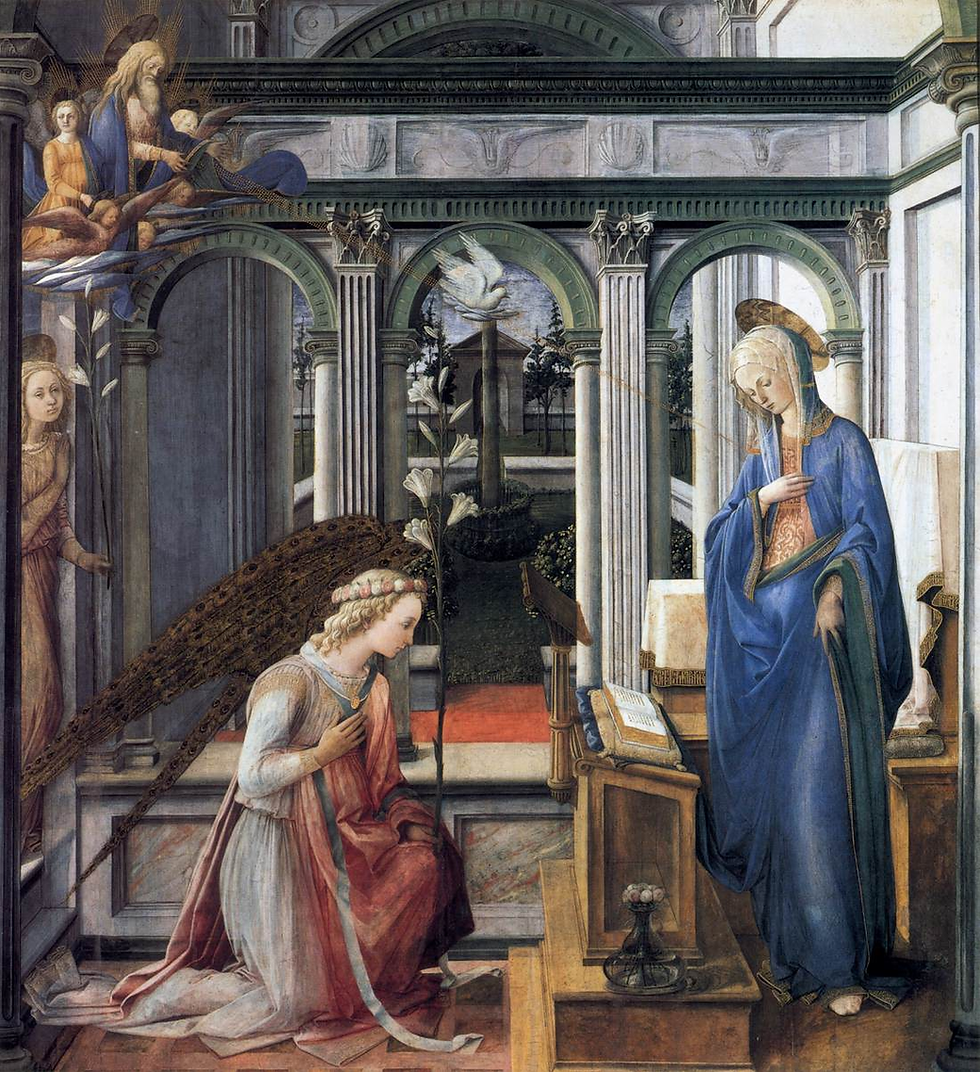Feast and Fast
- Fr. Brian Trueman

- Mar 24, 2023
- 4 min read
This weekend we celebrate two very different occasions as part of the liturgical calendar: the Solemnity of the Annunciation of the Lord on the 25th, Saturday during the day, and the Fifth Sunday of Lent, beginning with Saturday evening. So, my two messages this week will correspond to both realities.
I am, in our Lord, yours.
Fr. Brian Trueman
Annunciation
It’s hard to believe that we are already only 9 months away from Christmas with the Solemnity of the Annunciation of the Lord, the celebration of the beginning of the great work of our salvation with St. Gabriel’s message to Mary that she was to bring forth the God-man. We’ll be celebrating this Mass on Saturday the 25th at 9am. But I also wanted to talk about a great book I purchased recently in relation to this feast. The book is called, Solemnities: Celebrating a Tapestry of Divine Beauty, published by Ascension Press, and it contains many great insights into the seventeen sacred solemnities throughout the liturgical year. I can highly recommend it. Each solemnity has a page that looks at the readings and prayers of that particular day, a chosen piece of artwork with a commentary on how that art brings out the rich beauty and truth of the occasion, and a third page that contains different ideas or suggestions on how to practically live and celebrate that feast day. For the Annunciation, I’ll leave you with the piece of art chosen from the book along with a brief excerpt from the commentary on it, written by Denis McNamara.
“An elaborate background contrasts with the simplicity of the figures, the setting an erudite palace with architectural details only recently re-learned in the Italian Renaissance’s quest to recover the standards of ancient Rome. The Virgin’s womb will soon become the home of Christ the King, and so the “palace” which is the Virgin’s womb is expressed in her exterior surroundings. Large Corinthian columns, distinguished by their capitals rich with acanthus leaves, which have signified unmarried women since antiquity, mark arches supported by scrolled Ionic columns, which in turn signify maternity. So the place is more than a marker of status. It also speaks of the nature of Mary, who is soon to be both virgin and mother. Through the colonnade appears a walled garden with no gate, combining two allusions to the Virgin’s womb. In the prophet Ezekiel’s great vision (see Ezekiel 40-43), he sees a temple built without human hands into which God’s glory rushes through the east gate.
So God’s Presence has returned to his Temple, an apt allusion for Christ, who returns to the temple of Mary. The angel told Ezekiel that this gate must remain shut, since the Lord God had entered through it, echoing Isaiah 7:14: “The Virgin will conceive and bear a son.” The enclosed garden, an image expressed by King Solomon to his bride in the Song of Songs, now becomes fulfilled as a song of Christ, the new Solomon, to his bride the Church, all typified by the Virgin Mary. So enclosed garden and palace come together in the Virgin Mary, a typological fulfillment only heightened by the pillar which appears in the centre of the garden, which has traditionally been associated with Mary since columns marked places of importance, and therefore her singular role in salvation history.”
Veiling

This Sunday also marks the Fifth Sunday of Lent. This has traditionally been the Sunday when the practice of veiling statues, crosses, and crucifixes can be covered until the Easter Vigil. The Canadian Ordo notes this: “In the Diocese of Canada, the practice of covering crosses and images throughout the church from this Sunday onward may be observed. Crosses remain covered until the end of the celebration of the Lord’s Passion on Good Friday. They are uncovered at the beginning of the Easter Vigil.”
Traditionally, the Fifth Sunday of Lent began Passiontide, the week leading up to Holy Week which begins with the Palm Sunday of the Lord’s Passion, where we hear the lengthy Passion narrative in anticipation of Good Friday. As we come nearer to the end of Lent, our fasting becomes intensified, where even the good and glorious symbols of our faith become “hidden” temporarily, a fast for our eyes, only to be revealed after the work of our salvation is accomplished with Holy Week.
In the readings leading up to Holy Week, we hear how the tensions between Jesus and the religious authorities of his time are mounting and become more pronounced, and so their resolve to have him killed is made more evident. At one point, they even took up stones in order to kill him, but Jesus hid himself since his “hour” had not yet come (John 8 and 10). The practice of veiling is a way in which Jesus becomes “hidden” to us as well. Furthermore, as we hear recall the suffering Passion and its effects on our Blessed Lord, not only is his divinity hidden from the eyes of all, but even his humanity: “he had no form or majesty that we should look at him, nothing in his appearance that we should desire him. He was despised and rejected by others; a man of suffering and acquainted with infirmity; and as one from whom others hide their faces he was despised, and we held him of no account” (Isa 53), and in Psalm 22: “But I am a worm, and not human; scorned by others, and despised by the people.” For these reasons, our Saviour becomes hidden under the sad cloths of purple, and if it is fitting for the glory of our Master to become hidden, then his servants also should not appear, meaning images and statues of saints are covered. This more intense fasting of our eyes is lifted when we shall be able to feast once again at Easter.
.png)








Comments